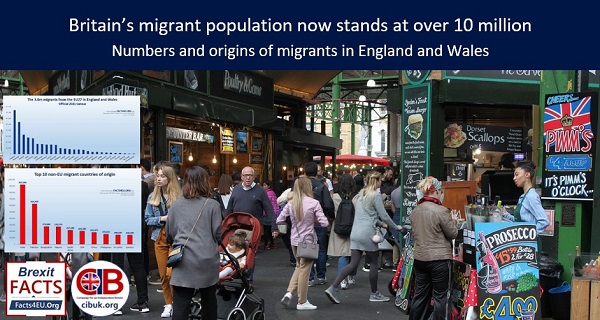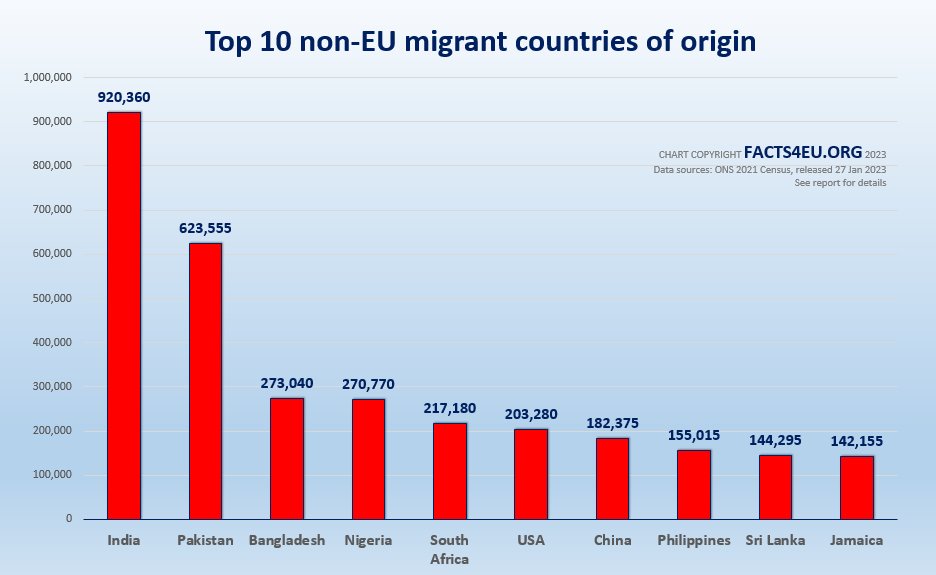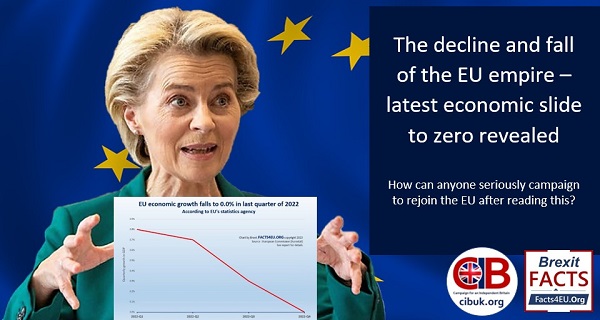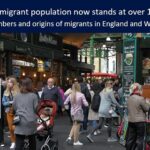Brexit Britain’s migrant population now stands at over 10 million – and growing

Latest official figures reveal details of who has come and where they’re from
CIBUK.Org summarises the numbers and origins of migrants in England and Wales
It’s official. Over 10 million (10,021,475) people permanently living in England and Wales were not born anywhere in the United Kingdom. This out of a total population of 59,597,565.
On Friday (27 Jan 2023) the Office for National Statistics published its latest report on the 2021 Census in England and Wales. We do not have the data for Scotland and Northern Ireland as they conduct their own censuses and are further behind.
Note: The information in this report comes from the official Census. It measures the numbers of those who actually submitted their information, not necessarily all those who are actually living in the country. It does not include illegal migrants, nor those who failed to provide information.
.
We have divided this summary report into two parts:-
- Born in the EU27
- Born in the rest of the world
In a subsequent report we will look at the impacts of this immigration.
Summary
1. Migrants from the EU27
[Source: Office for National Statistics report on 2021 Census, 27 Jan 2023.]
Below are the numbers for each EU27 country. In a section below we then highlight some of the changes over the past 20 years.
- Poland : 743,085
- Romania : 538,840
- Ireland : 324,670
- Italy : 276,670
- Germany : 263,365
- Spain : 166,915
- Lithuania : 164,160
- Portugal : 156,300
- France : 155,320
- Bulgaria : 150,255
- Hungary : 95,400
- Latvia : 88,585
- Greece : 80,120
- Slovakia : 73,940
- Cyprus : 72,560
- Netherlands : 67,375
- Czechia : 46,170
- Sweden : 33,005
- Belgium : 31,270
- Malta : 24,475
- Denmark : 21,015
- Austria : 16,855
- Finland : 13,580
- Croatia : 12,825
- Estonia : 10,015
- Slovenia : 3,535
- Luxembourg : 2,165
- EU27 TOTAL : 3,632,470
© Brexit Facts4EU.Org 2023 – click to enlarge
10 out of the Top 20 countries of origin in the world
are now EU27 countries
2. Migrants from non-EU countries
[Source: Office for National Statistics report on 2021 Census, 27 Jan 2023.]
Below are the numbers of migrants from the Top 10 non-EU countries of origin around the world.
- India : 920,360
- Pakistan : 623,555
- Bangladesh : 273,040
- Nigeria : 270,770
- South Africa : 217,180
- USA : 203,280
- China : 182,375
- Philippines : 155,015
- Sri Lanka : 144,295
- Jamaica : 142,155
- TOTAL NON-EU : 6,389,005
© Brexit Facts4EU.Org 2023 – click to enlarge
Some of the biggest changes (EU and non-EU) in the last 20 years
Between 2011 and 2021 migrants to England and Wales from Romania and Italy have entered the top six in the world, while the United States and Jamaica have fallen out of the top 10.
Looking further back, there are even greater differences between 2001 and 2021. Some of the more notable changes include Kenya falling out of the top 10, with Germany, Bangladesh and South Africa all moving further down the order. In addition, three of the top 10 countries in the world in 2021 did not appear in the top 10 in 2001. These countries were: Poland (then number 18), Romania (number 86) and Nigeria (number 14). The rise in position of both Poland and Romania is because they joined the EU in 2004 and 2007 respectively, and therefore gained entitlement to free movement.
Observations
When looking at our EU27 table above it must be remembered that the populations of these countries vary considerably. For example, as the most populous country in the EU it is not surprising to find Germany high up.
Conversely there are very small countries such as Lithuania and Latvia which appear much higher in the list than would be expected in proportion to their populations.
Statistical note: We chose to use “country of birth” rather than “nationality”. There are anomalies whichever is chosen. For example, British children of parents serving in the British Army on the Rhine count as being born in Germany. Alternatively, if nationality is used then “Polish” would not include people born in Poland who have subsequently become British citizens.
The overall picture
Overall, the headline figures are quite startling. More than one in six people living permanently in England and Wales are not UK-born. If one then subtracts those born in Scotland but living in England and Wales (648,420), as well as subtracting those born in Northern Ireland (198,345), then the ‘homegrown’ total is down to 48,729,325.
This means that nearly one in five people (18.24%) living in England and Wales were not born there. The English and Welsh are sharing their homelands with nearly 11 million (10,868,240) people who were born elsewhere.
Does this matter? Is it a good or a bad thing?
We believe the public should have access to clear information – about the United Kingdom, about the European Union, and about the UK’s relations with the rest of the world.
There are sound arguments for welcoming people from around the world. However a problem arises when successive governments fail to increase the level of public services such as the NHS, schools, housing stock, roads, rail transport and many other aspects of infrastructure – in line with population growth.
In a second report we will look at the question of ‘net benefit’. Has the level of legal immigration had a positive or negative impact on people’s lives? We therefore kindly ask those wishing to comment on today’s report to restrict themselves to the contents above. There will then be ample opportunity to comment on our subsequent ‘impacts’ report.
Please support our work today, to keep us going
Main image: montage © Facts4EU.Org
This report has been co-published with our affiliated organisation, Brexit Facts4EU.Org.
For the original report, click here: https://facts4eu.org/news/2023_jan_10_million_plus









